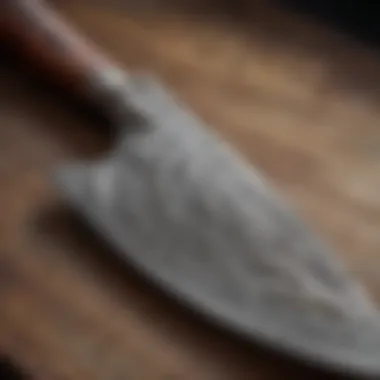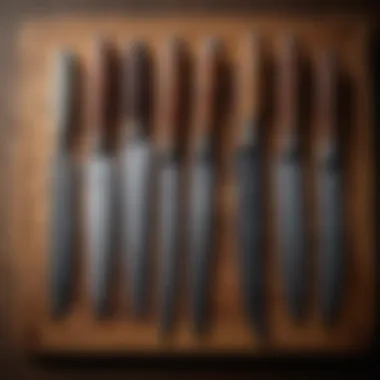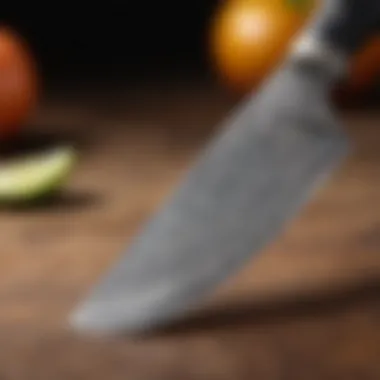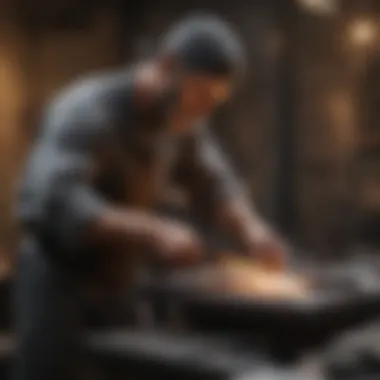Top Rated Damascus Chef Knives: A Comprehensive Guide


Intro
The art of cooking transcends basic preparation. Damascus chef knives seize a prominent role in the modern culinary landscape. Their allure is not solely based on aesthetics. Historical significance also factors into their appeal, crafting their identity from centuries of intricate workmanship. These knives marry functionality with tradition, enabling the culinary enthusiast to navigate the kitchen like a seasoned artist.
For those passionate about quality kitchen tools, understanding the unique attributes of Damascus steel is vital. Stemming from ancient techniques, this form of steel exhibits resilience and sharpness that's unique among culinary instruments. In the subsequent sections, we delve into what distinguishes top-rated Damascus chef knives, highlighting criteria for selection. Readers will encounter a broad spectrum of brands and notable models, effectively linking the heritage of the knife to the contemporary chef’s requirements.
Being well-versed in these nuances empowers both novice and experienced cooks to invest in tools that will last longer and enhance their culinary experience.
Prelude to Damascus Steel
Damascus steel is more than a material; it is a legendary fabric that has captivated chefs and artisans worldwide. In the realm of culinary tools, particularly chef knives, understanding Damascus steel is crucial. It signifies durability, aesthetic elegance, and exceptional performance. As we explore the following components in this guide, we will unveil the benefits of choosing a Damascus chef knife for modern kitchens.
History of Damascus Steel
The origin of Damascus steel can be traced back to around 300-500 AD in regions of the Middle East and India. The term itself refers to a method of forging metal that produces a distinct patterned appearance. This technique was initially used for weaponry but gradually transcended its origins in warfare.
Old Wootz steel imported from India holds great significance in its development. Wootz was known for its superior sharpening qualities, combined with distinct patterns so characteristic of true Damascus. The unique folding and forge-weld techniques enabled blacksmiths to create blades that were not only aesthetically pleasing but also incredibly resilient. Over centuries, this craftsmanship faded due to various industrial advancements. However, a renewed interest in Damascus knives has emerged in modern cuisine, calling for high-quality kitchen tools that illustrate skill and power in both training and execution.
The Unique Characteristics of Damascus Steel
The appeal of Damascus steel extends beyond its historical narratives. Noteworthy characteristics contribute remarkably to its standing in kitchenware, specifically chef knives.
- Durability and Strength: The multiple layers of steel provide both longevity and flexibility. The creation method of blending various metal types leads to increased strength.
- Edge Retention: Damascus knives often utilize high-carbon steel, which enhances their ability to maintain a sharp edge. This characteristic is indispensable for culinary experts who demand precision.
- Aesthetic Patterns: The visual allure of the distinct patterns produced during the forging process cannot be overlooked. Each Damascus knife is unique in design, making it not only a tool but a work of artistry.
Armed with knowledge about its storied relevance, let's examine why understanding Damascus steel is essential for selecting a suitable chef knife in the forthcoming sections.
Understanding Damascus Chef Knives
Understanding Damascus chef knives is crucial for anyone serious about culinary arts. The distinct design and engineering behind these tools offer unique benefits that surpass standard chef knives. It's essential to comprehend their value when selecting the right knife for your needs.
What Makes a Knife 'Damascus'?
A Damascus knife is characterized by its wavy or mottled pattern on the blade, a result of combining different types of steel. This blending process enhances not just aesthetics but also functionality. A typical Damascus chef knife consists of multiple layers, usually around 32 to 64 layers, folded together.
This complexity leads to improved strength and sharpness compared to single-piece knives. The carbon content in the core steel also contributes to durability and edge retention. Each knife tells its own story of craftsmanship, making them visually appealing and practical at the same time.
Notably, the craftsmanship is vital when purchasing Damascus knives. Chinese and Japanese styles may employ different techniques and steels, which can affect usage.
Benefits of Using Damascus Chef Knives
Using Damascus chef knives presents several advantages:
- Sharpness and Durability: These knives tend to hold their edge much longer than standard stainless steel knives. If properly maintained, they care for themselves as much as one must care for them.
- Aesthetic Appeal: The unique patterns create knives that can be functional artwork in your kitchen. This personal connection with a tool can enhance the cooking experience.
- Comfortable Handling: Many Damascus chef knives are ergonomically designed. This increases safety and eases long cooking sessions.
- Versatility: Whether slicing vegetables or carving meat, these knives offer better control, which can lead to more precise results. Chefs of all levels can benefit from this.
An investment in a quality Damascus chef knife can vastly elevate culinary practices, allowing for both enjoyment and precision in cooking tasks.
Given these attributes, it's clear why understanding Damascus chef knives is important for both cooking enthusiasts and professional chefs. Engaging with these tools transforms meal preparation into a more enjoyable and efficient process.


Key Features of Top Rated Damascus Chef Knives
When selecting a top-rated Damascus chef knife, understanding key features is essential. These components significantly influence a knife's performance, durability, and user experience. Here, we will delve into the critical aspects that differentiate well-crafted Damascus knives from other types, ensuring that culinary enthusiasts make informed decisions suitable for their cooking styles.
Blade Composition
The blade composition is paramount when assessing the quality and efficacy of a Damascus knife. Typically, these blades are crafted from layers of high-carbon steel, resulting not only in a visually striking composite but also contributing to superior functionality. The type of steel used is vital, with many high-rated knives often employing VG-10, AUS-10 or 1095 steel for their edge retention and sharpness.
Damascus steel is acclaimed for providing a fine blend of hardness and flexibility. Well-made Damascus blades achieve hardness measured in Rockwell scale, often around 58 to 61. This range ensures the knife delivers both strength for cutting through tougher materials while maintaining adequate toughness against chipping and fractures. The unique layering techniques harnessed in making the blade enable them to resist corrosion and retain an edge longer than ordinary steel.
Really, counterfeit Damascus blades exist, often produced from inferior quality steel. Thus, consumers must pay attention to authentic makers who provide certificates or documentation that confirms the steel's origin. Ensuring you understand the blade’s material can save time and frustration in the kitchen, affecting efficiency in meal prep.
Handle Material and Design
In addition, the handle of a chef knife plays a crucial role in comfort and usability. The material and design impact the grip, durability, and temperature control during usage. Popular handle materials include wood, such as pakkawood, which is not only aesthetically pleasing but also comfortable to hold, absorbing sweat and moisture effectively. Another option prevalent among chefs is resin-impregnated handled material, which e.g., provides a secure grip while remaining long-lasting.
The design must also advocate for a good fit. Handles come in various shapes and designs, impacting the grip and maneuverability. For optimal usage, wavy jedged handles encourage ergonomic gripping while minimizing hand fatigue. By preventing slippage during prolonged use, a well-crafted handle can enhance both precision and efficiency.
Qu intessentially observing simple designs like the double-riveted or bolster styles aids in an understanding of both balance and robustness. The importance of secure, ergonomic handles often correlates with better kitchen performance.
Weight and Balance
Further, a harmonious blend of weight and balance can make a considerable distinction in knife excellence. Ideally, a top-rated Damascus chef knife’s weight is strategically distributed. This thoughtful design favors a system of leverage, which allows for smoother slicing motions while requiring less force.
Generally, a heavier knife can excel for challenging cutting tasks allowing personal strength to carry through thick meats or vegetables. Conversely, lighter knives perform dexterously in intricate tasks such as mincing herbs. Knives should feel balanced when held, having the center of gravity located close to the bolster where the blade meets the handle.
Understanding these characteristics enables chefs to select tools that resonate with their cooking styles, encouraging an entertaining kitchen experience. Achieving precision and consistency often lies directly in not just how the knife looks but how integral each aspect of design and material interacts during use.
In essence, the importance of these features cannot be overstated when selecting the finest Damascus chef knife. Their combined effects can significantly enhance culinary performance, ensuring effective and efficient meal preparation.
Selecting the Right Damascus Chef Knife
Choosing the right Damascus chef knife can greatly impact both culinary effectiveness and enjoyment in the kitchen. Each cook has different needs, and identifying these makes it easier to select a knife that will complement their style. Below, we delve deeper into aspects that guide the choice of the perfect knife—culinary needs and budget considerations are crucial elements.
Identifying Your Culinary Needs
Before purchasing a Damascus chef knife, think carefully about what you usually cook and how you like to prep your food. Popular styles require different knives. For instance, someone who frequently prepares meat might favor a heavier, sturdier blade suited to slicing through tougher proteins. Conversely, an individual focused on fine vegetables may appreciate a lighter, more nimble knife to ensure precise cuts.
Here are some key points to help clarify your culinary needs:
- Cooking Style: Consider whether you prefer chopping, slicing, or dicing. The type of knife can enhance efficiency and the enjoyment of preparation.
- Frequency of Use: If cooking is a daily activity, investing in a high-quality knife could offer long-term benefits.
- Skills Level: Amateur cooks might begin with more forgiving and versatile options rather than specialty knives.
- Size and Comfort: Ensure the knife feels right in your hand. Length and grip can greatly influence handling and cutting precision.
By determining your culinary habits, you can ensure that your Damascus chef knife is well-suited to your kitchen sessions.
Budget Considerations
When considering which Damascus chef knife to purchase, budget plays a vital role. High-quality Damascus knives come at varied price points, and it’s feasible to find options that cater to both modest and lavish budgets.


Understanding where to spend can make your investment worthwhile. Here are key budget considerations:
- Quality vs. Cost: Prioritize purchasing quality knives that ensure longevity over cheaper knives that may offer mediocrity.
- Brands: Renowned brands like Shun and Dalstrong may carry higher prices, but their craftsmanship and materials justify the cost.
- Long-term investment: A good knife can last decades with proper care. Consider it an investment in your culinary future.
- Sales and Discounts: Watch for seasonal sales or promotions that could introduce you to top-tier products at a fitting price.
Effective budgeting allows for a well-informed choice. Make sure that the knife you pick not only fits within your budget but also adheres to your cooking styles and preferences.
Consideration is key—comparing features against your needs ensures that each dollar spent enhances the functionality of your kitchen.
Top Rated Damascus Chef Knife Brands
Selecting a Damascus chef knife often comes down to brand reputation and craftsmanship. Top-rated brands carry a legacy of quality and reliable performance, which is essential to any culinary enthusiast. Some brands focus on traditional methods and materials, while others innovate with modern production technology. Understanding these nuances can help you choose a knife that meets your specific culinary needs. The right brand buys not just a knife, but also assurance of quality and service.
Brand Reputation and Craftsmanship
The reputation of a knife brand is closely tied to its craftsmanship. A well-regarded brand likely uses high-quality materials and precise techniques in manufacturing. Every detail, from the blade composition to the handle design, contributes to the durability and effectiveness of their knives. For instance, a brand known for its artisanal family methods might place greater emphasis on craftsmanship than mass-produced knives. This dedication speaks volumes about the knife's longevity and performance in the kitchen.
With craftsmanship being the foundation of a good knife, elements such as the integrated design and balance between blade and handle become essential considerations. The objective perspective provided by reviews, as well as insights into manufacturing practices, can illuminate the benefits that each brand offers.
Detailed Reviews of Specific Brands
Shun
Shun is widely recognized for blending traditional craftsmanship with modern technology. Their knives often showcase the stunning beauty of wave patterns common in Damascus steel. This not only enhances appearance but reinforces strength. Shun also implements an exceptional hardness in their VG-MAX steel, achieving outstanding edge retention. This quality is what makes Shun a popular choice among professional chefs and home cooks alike.
Unique Feature
Their D-Shaped handles enable an ergonomic grip that provides comfort even during extensive use. Depending on whether the user prefers a contemporary feel or a more traditional look, Shun offers various models that can fit personal style.
Dalstrong
Dalstrong stands out for its value. The knives are often priced competitively while offering features like a well-balanced weight and lightweight handling. Their integration of attractive design alongside top-end materials draws many aspiring home chefs.
Unique Feature
A specialty of Dalstrong is their bold aggressive aesthetics, including striking black and gold handle designs, which also provide strong grip and control. Reviews indicate excellent sharpness out of the box and ease of maintenance, making it a top choice for many cooks.
Miyabi
Miyabi is synonymous with precision. Known for their impeccable edge geometry and craftsmanship, they source their materials from distinguished metals used in traditional Japanese blades. The attention to detail on each knife renders it not just a tool but an object of fine art.
Unique Feature
The use of micro-carbide powder steel in select models results in superior performance in sharpness and retention. Miyabi knives often appeal to those who seek perfection in both form and function.
Yoshihiro
Yoshihiro knives enchant users with another layer of tradition. Their commitment to authenticity stems from Japan's historic sword-making heritage. Every knife is a testament to this mastery and reflects high stability. As a tribute to aged practices, Yoshihiro embraces simplicity blended with functionality.


Unique Feature
An interesting aspect of Yoshihiro is the utilization of materials from high carbon steel, leading these knives to acquire a natural sharpness. Users regularly state its hand-crafted nature ensures longevity, rivaling other options in lasting quality and edge retention.
Choosing a knife brand is like selecting a partner in the kitchen; it needs trust and compatibility to yield great results.
Selecting the right Damascus chef knife brand means valuing both reputation and craftsmanship, aligning them with personal culinary concerns. Consistent and thoughtful performance across daily tasks becomes paramount in cultivating interest in cooking. The considerations above guide culinary enthusiasts toward options satisfying both style and functionality.
Caring for Your Damascus Chef Knife
Caring for your Damascus chef knife is vital for maintaining its performance and longevity. Unlike synthetic blades, hand-forged Damascus steel requires specific care to ensure that it not only remains sharp but also preserves its stunning aesthetics. In this section, we will focus on two main aspects: cleaning and maintenance tips, as well as sharpening techniques. Proper attention to these areas will enhance your cooking experience and guarantee that your investment remains valuable for years to come.
Cleaning and Maintenance Tips
To appreciate the beauty and functionality of a Damascus chef knife, regular cleaning is crucial. The buildup of food particles and grease can lead to corrosion and compromises the steel's integrity. Here are some essential cleaning tips:
- Immediate cleaning: After using your knife, wash it in warm water with mild soap. This removes any residue that could affect the steel over time.
- Avoid abrasive materials: Do not use steel wool or other abrasive sponges to clean the knife. Soft sponges or cloths are more suitable.
- Dry thoroughly: Always dry your knife immediately after washing to prevent any rust formation on the surface. Standing water can lead to oxidation, which affects both the blade and the overall aesthetics.
When storing a Damascus chef knife, it’s also advisable to keep it in a safe place. You might use a magnetic strip, a knife block, or a protective sheath. This not only prevents physical damage but reduces unnecessary exposure to moisture.
“Regular care ensures that your Damascus chef knife remains an effective tool for culinary pursuits.”
Sharpening Techniques
Keeping a knife sharp is arguably the most significant aspect of care. A dull blade is not just inefficient—it can be dangerous. Proper sharpening ensures that the knife remains effective in various culinary tasks. Here are several techniques for sharpening your Damascus chef knife:
- Whetstone sharpening: This is the preferred method for many chefs. Use a high-grit whetstone for refining the edge. Always maintain a consistent angle to achieve an even blade.
- Honing steel: While it doesn’t sharpen, a honing steel helps in maintaining the edge between main sharpenings. Regular honing can greatly reduced the need for deep sharpening.
- Guided systems: If you are uncertain about sharpening manually, guided sharpening systems offer precision and simplicity. They create the proper angle for you, ensuring consistent results.
Consider a sharpening frequency of once every month or two, depending on usage. Following these techniques will keep your knife at optimal performance for slicing and dicing with ease.
Ensuring that your Damascus chef knife receives the utmost care helps amplify its function in the kitchen. With proper cleaning and sharpening, you will continue to enjoy its reliability and premium craftsmanship as you whip up culinary creations.
Finale: Embracing Damascus Chef Knives in Modern Kitchens
In today's culinary landscape, the significance of Damascus chef knives cannot be understated. These knives combine tradition with cutting-edge performance. As chef knives embody both history and innovation, understanding their value is essential for any serious cook.
The Future of Damascus Knives
Considering recent advancements in materials and manufacturing techniques, the future of Damascus knives appears promising. Trends show an increased focus on sustainability, with makers exploring eco-friendly materials while remaining loyal to the formal process of layering steel.
Moreover, chefs are becoming more informed about knife care and utilization. They appreciate lightweight options designed for versatility in high-paced environments or artistic presentations.
Expect to see a continuation of the adaptation and design tailored to various culinary practices. Styles incorporating ergonomics could become more mainstream as comfort in execution takes precedence. There is also growing interest from enthusiasts looking not just for utility but for artistry captured within each knife.
Final Thoughts on Selection and Use
Selecting a Damascus chef knife involves careful consideration of one's culinary needs. This not only includes functions for daily prep but also extends to the knife’s stylistic attributes that resonate on a personal level.
When purchasing, it is vital to invest time in researching reputed brands, defined by significant craftsmanship and durability. Reading through specific brand reviews gives a greater sense of product quality available in the market today.
Using these high-quality tools shouldn’t come with overwhelming routine pressure; it is important to profit from their precision while allowing for creative expression in cooking.
"A chef knife should be an extension of the hand, enhancing both technique and creativity."
The Damascus chef knife often leverages hours of artisanship in its creation, signifying more than a tool—it offers prowess for differentiation and innovation in every meal.







